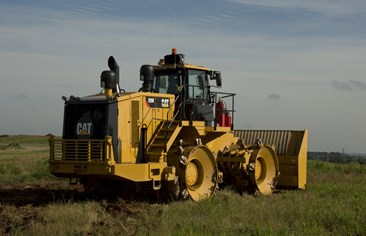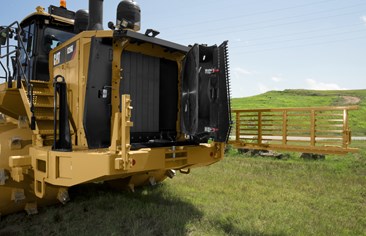Working across South Africa as well as Namibia in its niche construction, mining and industrial segments, Burma Plant Hire continues to modernise its earthmoving fleet, a recent addition being a Cat 826K landfill compactor now deployed on one of its longest serving contracts in the Western Cape.
Diversification has been a major success factor for Burma Plant Hire (Burma), a Cape Town based company that celebrates 12 years in business in 2015. Today Burma is one of the largest in its field within the Western Cape, and a growing force nationally and internationally, which since its establishment back in 2003 has seen progressive roll-outs with branches established in the Eastern Cape, the Northern Cape, Gauteng, and more recently Namibia in September 2014.
“From the onset, our focus has been on supplying specialist plant hire solutions to the industrial, mining and construction sectors,” says Theuns MA Burger, company founder, CEO and executive chairman, “combined with a strict adherence to health and safety practices. Safety is Burma’s number one priority in all areas of our business and more specifically in terms of plant utilisation, as well as operator proficiency training and certification.” In July 2011 Burma joined Raubex Group Limited, a company listed on the JSE.
There are now more than 600 units in Burma’s mixed hire fleet, a core component comprising Cat earthmoving machines supplied and supported by Caterpillar’s southern African dealer, Barloworld Equipment.
Historically, these machines have played a major role in expanding South Africa’s built environment and public infrastructure landscape. In its home province there are many Western Cape examples where Burma machines have been part of the construction mix. These include the Berg River Dam project; various developments at the Victoria & Alfred Waterfront precinct; the extension to Hospital Bend in Cape Town: a two year road widening and reconstruction project; works at the Green Point Stadium, one of the official South African 2010 FIFA World Cup venues; the R300 route upgrade in Cape Town; the Hemel to Aarde Road project, interconnecting Hermanus with the Western Cape town of Caledon, a central wheat growing hub and also a major tourist attraction for various boutique wine estates; plus the Colesburg N1 interchange project; and the N7 interchange near Durbanville.
In more recent years, the Northern Cape mining segment has been a new growth market for Burma, which already has a long established presence in this and the neighbouring Western Cape region for dedicated plant hire solutions supplied to contractors working on upgrades and extensions to the Sishen to Saldanha rail line. This is a rail corridor for iron and manganese ore exports destined for worldwide shipment via the Port of Saldanha. Burma continues to supply plant for this ongoing project. New lines include connections from the Kolomela Mine near Postmasburg through to Sishen.
Since 2010, plant hire to construction companies operating in this Northern Cape region have run in parallel with a progressive extension of allied services to the mining sector following Burma’s opening of a branch and parts distribution centre in Postmasburg. Plant hire solutions in mining include the supply of earthmoving equipment for the loading and hauling of waste materials, as well as the maintenance and construction of haul roads.
The first two machines purchased by Burma were acquired in 2003: namely a Cat 320C hydraulic excavator and a Cat 938G wheel loader. The Cat 938G, which has now recorded more than 23 000 hours, is still on daily hire. Since then, Burma’s mixed earthmoving fleet has seen a progressive expansion in its Cat units to meet diverse market needs in general industry. This includes the acquisition of four latest generation Cat 938K wheel loaders during 2014 and the delivery in January 2015 of a Cat 826K landfill compactor, the first unit to see operation within southern Africa.
“We are actively expanding our landfill business nationwide,” explains Burger, “to meet rising demand from both the private and municipal markets for class-leading mechanised solutions, our latest Cat 826K acquisition being a prime example.”
This machine is now deployed at the Vissershok hazardous waste site, a privately owned landfill bordering the N7 some 30 km north of Cape Town central. The Cat 826K joins an older Cat 816H compactor on a site where Burma has been operational since inception in 2003.







